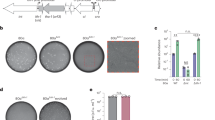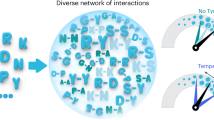This plasma protein offers the winter flounder extra protection against icy polar waters.
Abstract
Fish that live in the polar oceans survive at low temperatures by virtue of ‘antifreeze’ plasma proteins1 in the blood that bind to ice crystals and prevent these from growing. However, the antifreeze proteins isolated so far from the winter flounder (Pleuronectes americanus), a common fish in the Northern Hemisphere, are not sufficiently active to protect it from freezing in icy sea water. Here we describe a previously undiscovered antifreeze protein from this flounder that is extremely active (as effective as those found in insects) and which explains the resistance of this fish to freezing in polar and subpolar waters.
Similar content being viewed by others
Main
An antifreeze protein (AFP) known as type I was discovered in winter flounder 30 years ago2 and has been extensively characterized3,4 as an alanine-rich, amphipathic molecule that is a single α-helix with a relative molecular mass (Mr) of 3,300 and binds to a pyramidal plane of ice5. The concentration of type I AFP found in the fish's blood plasma during winter is about 10–15 mg ml−1 (ref. 6) and should result in a non-colligative freezing-point depression, or thermal hysteresis1, of 0.7 °C (Fig. 1a). This thermal hysteresis, coupled with the freezing-point depression attributable to the colligative effect of blood solutes (0.8 °C)7, would protect the flounder down to a temperature of only −1.5 °C, which is critically short of what is required to survive at −1.9 °C, the freezing point of sea water. What mechanism could account for the additional 0.4 °C of protection against freezing?
a, Thermal hysteresis activity as a function of the concentration of AFP: type I (winter-flounder isoform HPLC-6 (ref. 10), blue circles); insect (yellow-mealworm isoform 4–9, black squares); 5a-like protein, with relative molecular mass 16,683, isolated from winter-flounder plasma (red triangles). b, Fractionation of winter-flounder plasma by gel-permeation chromatography on Sephadex G-75. The absorbance at 230 nm (red) and at 280 nm (green), and thermal hysteresis activity (black triangles) are shown for fractions across the chromatogram. Insets: morphology of the ice crystals produced from peak fractions X, Y and Z. MALDI–TOF mass spectrometry was used to identify the AFPs present in each peak: peak X contains the 5a-like AFP ([M+H]+average=16,683.04); peak Y contains type-I isoform AFP-9 ([M+H]+monoisotopic=4,282.24); peak Z contains type-I isoforms HPLC-6 and HPLC-8 ([M+H]+monoisotopic values of 3,239.98 and 3,226.01, respectively).
To answer this question, we re-examined the thermal hysteresis activity of winter-flounder plasma and found it to be in excess of 2 °C. This is more than double the capability of the known type I AFP (Fig. 1a) and, when added to the colligative effect of plasma solutes, is more than enough to protect the fish below the freezing point of sea water. Lemon-shaped ice crystals that differ significantly from the hexagonal bipyramids obtained with pure type I AFP (Fig. 1b) indicate the presence of an unknown antifreeze protein.
The relative contribution of the two winter-flounder proteins to the antifreeze activity in the fish's plasma is illustrated by size-exclusion chromatography (Fig. 1b). Here the antifreeze activity in column-eluate fractions was measured as thermal hysteresis (total freezing-point depression less the colligative freezing-point depression of the buffer). The combined thermal hysteresis of fractions containing the larger protein (peak X in Fig. 1b) accounts for two-thirds of the total plasma thermal hysteresis, whereas the remainder (peaks Y and Z) is attributable to smaller proteins.
The size-separated antifreeze protein activities were associated with very different ice-crystal morphology (Fig. 1b, insets). The larger protein produced the lemon-shaped crystals seen in unfractionated plasma, whereas the smaller proteins produced hexagonal bipyramidal crystals typical of type I AFP. The identification of the type I AFP with Mr of 3,300, and of the less abundant one with Mr of 4,300, was confirmed by reversed-phase high-performance liquid chromatography and mass spectrometry (Fig. 1b legend).
We further purified the larger AFP by anion-exchange chromatography and three rounds of ice-affinity purification8. The Mr of the resulting AFP was 16,683, which is comparable to, but distinct from, the Mr of 16,267 that is predicted for the exported product of a winter-flounder gene known as 5a (ref. 9). The two proteins differ slightly in their amino-terminal sequence and amino-acid composition. At the time of its discovery, the 5a gene was dismissed as an antifreeze-protein pseudogene, largely because the protein it encodes would have been grossly different from type I AFP and had never been detected in the flounder.
The newly discovered flounder protein that so closely resembles the 5a product is extraordinarily active in comparison with other fish antifreeze proteins (Fig. 1a). At a concentration of 0.1 mg ml−1 it provides 1.1 °C of thermal hysteresis, equivalent to that of an insect antifreeze protein, whereas type I AFP and other fish antifreeze proteins at this concentration depress the freezing point by less than 0.1 °C.
This protein has remained undetected for 30 years because it is extremely labile and present in only moderate quantities. It irreversibly loses all activity at room temperature and at low pH — conditions previously used in purifying antifreeze proteins2. The circulating concentration of this highly active protein is about 0.2 mg ml−1, which is some 50-fold less than that of type I AFP.
The evolutionary relationship between our 5a-like antifreeze protein and type I AFP, which also contains short tracts of alanine, remains to be solved.
References
Fletcher, G. L., Hew, C. L. & Davies, P. L. Annu. Rev. Physiol. 63, 359–390 (2001).
Duman, J. G. & DeVries, A. L. Nature 274, 237–238 (1974).
Yang, D. S., Sax, M., Chakrabartty, A. & Hew, C. L. Nature 333, 232–237 (1988).
Sicheri, F. & Yang, D. S. Nature 375, 427–431 (1995).
Knight, C. A., Cheng, C. C. & DeVries, A. L. Biophys. J. 59, 409–418 (1991).
Slaughter, D. & Hew, C. L. Can. J. Biochem. 60, 824–829 (1982).
Scott, G. K., Davies, P. L., Kao, M. H. & Fletcher, G. L. J. Mol. Evol. 27, 29–35 (1988).
Kuiper, M. J., Lankin, C., Gauthier, S. Y., Walker, V. K. & Davies, P. L. Biochem. Biophys. Res. Commun. 300, 645–648 (2003).
Davies, P. L. & Gauthier, S. Y. Gene 112, 171–178 (1992).
Hew, C. L. et al. Eur. J. Biochem. 160, 267–272 (1986).
Author information
Authors and Affiliations
Corresponding author
Ethics declarations
Competing interests
The authors declare no competing financial interests.
Rights and permissions
About this article
Cite this article
Marshall, C., Fletcher, G. & Davies, P. Hyperactive antifreeze protein in a fish. Nature 429, 153 (2004). https://doi.org/10.1038/429153a
Issue Date:
DOI: https://doi.org/10.1038/429153a
This article is cited by
-
Biochemical response of two earthworm taxa exposed to freezing
Journal of Comparative Physiology B (2023)
-
Cryofouling avoidance in the Antarctic scallop Adamussium colbecki
Communications Biology (2022)
-
Effect of pH on the activity of ice-binding protein from Marinomonas primoryensis
Extremophiles (2021)
-
Draft genome sequences of bacteria isolated from the Deschampsia antarctica phyllosphere
Extremophiles (2018)
-
Concentration-dependent oligomerization of an alpha-helical antifreeze polypeptide makes it hyperactive
Scientific Reports (2017)
Comments
By submitting a comment you agree to abide by our Terms and Community Guidelines. If you find something abusive or that does not comply with our terms or guidelines please flag it as inappropriate.




